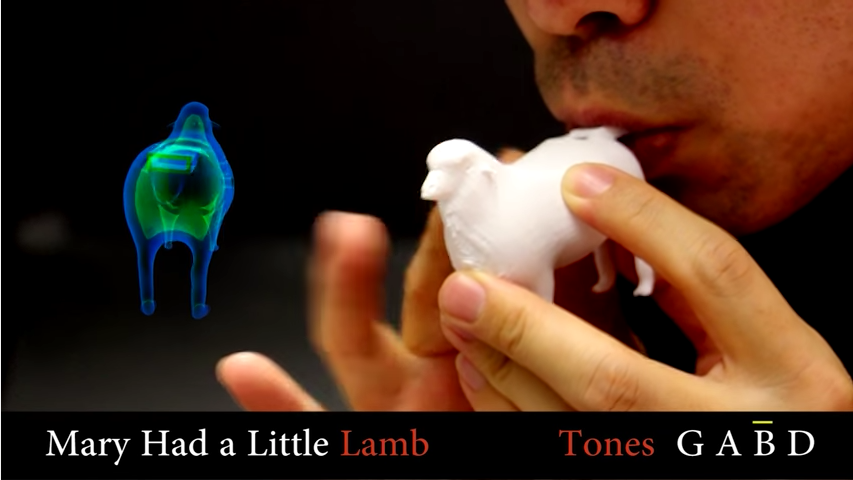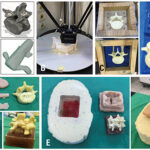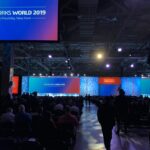

Like many junior high school students, I opted to choose an instrument to study and play in the school’s musical ensemble, or band, though I had a college professor who told our ensemble that it was only a band if we were on our feet and marching (I did that as well). Following in my mother’s footsteps, I chose the smallest instrument that required the most oxygen to play – the mighty flute, less than two lbs. in all its silvery glory. I hear all of you low brass players out there snickering at my use of the word ‘mighty,’ and I am actively ignoring you. I started with my mother’s old Bundy, and later switched to a Gemeinhardt in high school, when I joined the marching band. I was a flutist for about eleven years, from sixth grade until my sophomore year of college, and though I couldn’t play a lick now (my embouchure is long gone), I remember the days of practicing scales, pep tunes, and concertos. So I was pretty excited to hear about a fascinating project developed by Autodesk Research and Dartmouth College – researchers were able to design and 3D print free-form wind instruments with a tool they call the Printone!
Free-form instrument design is pretty difficult, because of the complex relationship between geometry and resonance, or the physical phenomenon that occurs when an incident wave creates a large reflection wave at a specific frequency. Most wind instruments, though they can be as different as flutes and trumpets, have a similar tube-like shape, designed and tuned by an expert. You play different tones, or notes, on a wind instrument by creating what’s called acoustic resonance: you blow air into the instrument, and then control the resulting sound by closing and opening multiple finger holes. For instance, to play a B flat note on the flute, you generally cover three finger holes, though this does vary a little depending on the type of flute (yes, there’s more than one).
The project was called “Printone: Interactive Resonance Simulation for Free-form Print-wind Instrument Design.” Printone gives people the ability to create functional musical wind instruments out of fun 3D shapes, such as rabbits, sheep, or stars. The 3D user interface for Printone is made up of geometric editing tools, used to place the finger holes and the fipple (mouthpiece).
Beginning with an input triangle mesh, you first add an internal, hollow cavity, and then position and orient the fipple. It must be situated so it can be easily be blown into, in order to create the notes. Then you uniformly scale the object, in order to set the lowest note, and then place the finger holes. By changing the size of the finger holes, you’re able to shift the note. Instead of manually tuning multiple finger holes, you simply click AutoTune, and the system will find a set of finger hole sizes that produce the notes you want it to. You get resonance simulation results as feedback, so you’re able to adjust the position of the finger holes if necessary.

The sound of an instrument is related to its resonance. The research paper explains that to find the resonance frequency, you have to analyze the minimum eigenvalue of the system matrix. It’s pretty complicated, but the researchers were able to come up with a method of estimating the resonance frequency at interactive rates; see the paper for more details.
In order to prove that the notes in the Printone tool match real musical notes, they use a chromatic tuner (anyone who was in band will remember one of these sitting on your conductor’s music stand). Using this approach, the research team says you should be able to create a novel wind instrument in about 30 minutes! This includes time spent designing the instruments – making sure the mouthpiece is unobstructed, and the finger holes are placed so as to allow reliable grasping of the actual instrument. The researchers themselves designed and played easily recognizable songs on 16 different instruments!
The Printone tool is written in C++, and most of the instruments were 3D printed using PLA filament on a MakerBot Replicator 2 3D printer. To create the necessary empty cavity inside the musical instrument’s shape, they cut the model in half using standard mesh editing software, printed each half separately, removed the support material from inside the cavity, and later glued both halves together. However, with a powder-based 3D printer, the cutting would be unnecessary, because they would be able to extract the powder through the finger holes. They did print a few different versions of the sheep instrument, one with a Stratasys Objet260 Connex3 3D printer using VeroWhitePlus material, and one with an Autodesk Ember 3D printer using UV-curable resin material. Even without sanding, grinding, or smoothing the interior, the results of the 3D printed instruments were still pretty accurate.
Printone enabled the research team to receive feedback during the editing and designing process. Usually, this type of sound simulation is difficult to accomplish, and the only 3D printed instruments you see most of the time are of the surgical variety (unless you were at the 2015 Inside 3D Printing Mumbai Conference and Expo). But the costs and complications were lessened by the tool’s frequency prediction process. If you want to learn more about Printone, and see some of the different instruments being played, check out the video below:
Discuss in the 3D Printed Instruments forum at 3DPB.com.
If you're looking to get architectural 3D animation in the USA, our service provides an exceptional way to bring your architectural concepts to life through dynamic, immersive visuals. Through our platform, you can easily request high-quality 3D animations that showcase your designs in motion, offering a detailed view of your project from multiple angles and perspectives. Whether it's for a real estate development, a commercial building, or an urban planning project, our expert team ensures that every detail is captured in a visually compelling animation.
Through our website, you can seamlessly get architectural 3D animation tailored to your project’s specific needs. With our help, you can offer potential clients or investors an engaging experience that goes beyond static images. By integrating CGI animations with real-world settings, lighting, and textures, our team creates a lifelike experience that allows your audience to interact with your project as though it were already built. This service is perfect for presenting complex designs in a clear, visually attractive way that stands out in the competitive architectural market.




